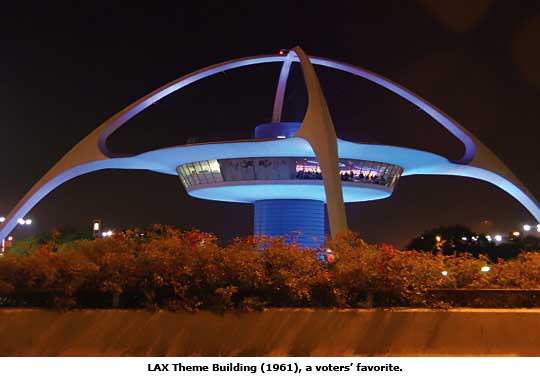Pandora's Box Of '60s Architecture

Ten months have passed since the Los Angeles Conservancy launched 'The Sixties Turn 50,' a broad initiative celebrating greater Los Angeles' rich legacy of 1960s architecture, which began turning 50 years old this year. The Conservancy and its volunteer Modern Committee launched this program to foster the preservation of important 1960s architectural gems before it's too late.
The 'Sixties Turn 50' experience was thrilling, eye opening, and a bit like opening Pandora's box. The Conservancy had fun and learned a lot.
A host of events, ranging from in-depth tours to a family picnic, showcased the '60s built environment of L.A. County. A dedicated website (laconservancy.org/sixties) promoted other local events related to the 1960s, let people vote on their favorite '60s sites (see sidebar story here), featured an interactive timeline, compiled photos through Flickr, and more.
In addition, a photography contest shared the '60s vision of students and adults. 'Last Remaining Seats,' the Conservancy's annual series of classic films in historic theatres, featured three films either made in or relevant to the '60s. Like a language immersion program, the Conservancy focused on 'all sixties, all the time.'
Here are some of the lessons learned:
1. Los Angeles has a greater '60s legacy than previously imagined. Sixties buildings are everywhere! The Conservancy knew the decade was an important time in the area's development, but even they were surprised at what they discovered once they scratched the surface.
Greater Los Angeles in the 1960s was the center of the aerospace industry, the site of a continuing postwar population boom, and home to unprecedented expansion, particularly in large-scale development. An incredible amount of the area's development occurred during this period. While not all of it merits preservation, this vast set of resources has come into high relief and deserves examination.
2. A lot of people care about this legacy. The Conservancy had a great response to the program, from national press coverage to individual engagement. The 'People's Choice Top 60 of the Sixties,' bore this out. The Conservancy had more than 2,000 votes for this unofficial list of popular '60s sites throughout L.A. County.
Who won, you ask? See the inset story here for the top picks, and visit laconservancy.org/sixties for the full list, photos, descriptions, and a map. In addition to voting for their favorite candidates, people let the Conservancy know about other '60s sites not on their radar.
3. But not everyone cares. Alas, the Conservancy also learned (well, they had an inkling) that not everyone favors preserving 1960s buildings. 'The Sixties Turn 50' raised plenty of eyebrows, even within the preservation community. Some people don't believe a building younger than they are could be considered historic; others have understandable resentment toward buildings that rose from the ashes of older landmarks.
Downtown L.A.'s iconic Atlantic Richfield building (Morgan, Walls, & Clements, 1928) was razed in the late '60s and replaced with the monolithic ARCO Towers (A. C. Martin & Associates, 1972), now known as City National Plaza. The Victorians of Bunker Hill fell to the city's new financial and cultural hub, including the Music Center of Los Angeles County (Welton Becket & Associates, 1964-1967). As devastating as these losses were, the fact remains that the newer buildings have since gained significance in their own right.
'The Sixties Turn 50' spurred important debate and conversation in the preservation community. It's difficult to preserve the recent past -- just ask the founders of the Conservancy's 'Fifties Task Force,' now known as the Modern Committee (ModCom). This volunteer group was formed in the 1980s, when it was a struggle for many to accept postwar '40s and '50s architecture as historic -- something preservationists take for granted today.
4. Those who care can't afford the luxury of a 50-year threshold. The premise behind 'The Sixties Turn 50' was that buildings from the decade have started turning 50 years old. While not a hard-and-fast requirement in most cities (including Los Angeles), the age of 50 is a widely accepted threshold for a building's consideration as historic. This program underscored that -- particularly in the constantly changing landscape of Los Angeles -- 50 years is too long a waiting period for many Modern structures, which have been known to meet their fate long before they're 'old enough' to be taken seriously.
In fact, some people questioned why the Conservancy wasn't publicly addressing even younger structures. Are you ready for 'The Seventies turn 40'? The program spurred conversation about landmarks of the future, places for which a constituency is needed now, before they become threatened with demolition. Not every old building is historically significant, and many newer buildings are already significant -- such as Frank Gehry's Walt Disney Concert Hall, which is only seven years old.




